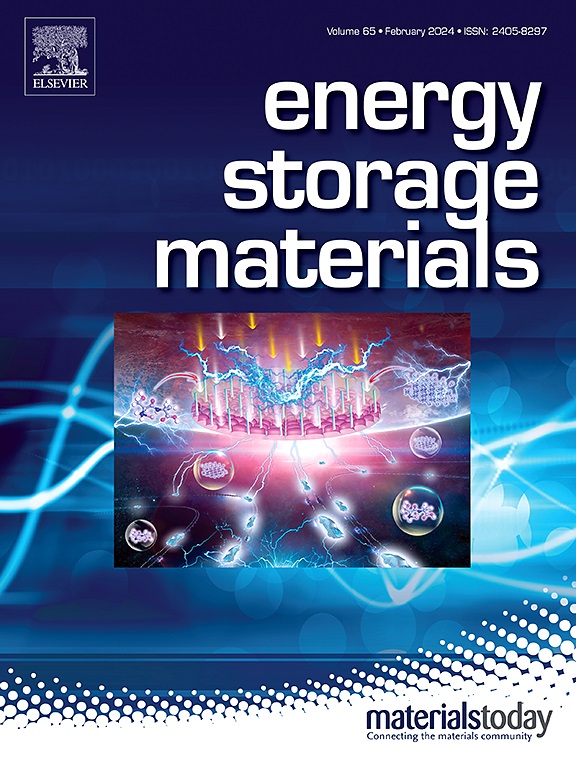Anion Screening in Ether-Based Electrolytes for Boosted Sodium Storage at Low-Temperature
IF 18.9
1区 材料科学
Q1 CHEMISTRY, PHYSICAL
引用次数: 0
Abstract
The electrolyte composition plays a crucial role in determining the electrochemical performance of sodium-ion batteries (SIBs), particularly at low temperatures (LTs), where sluggish ion transport and intensified parasitic side reactions severely compromise battery stability and efficiency. However, previous electrolyte engineering efforts have primarily focused on solvent optimization to regulate Na+ solvation, the fundamental role of salt anions in modulating the electrode-electrolyte interface (EEI) and solid electrolyte interphase (SEI) formation remains insufficiently explored. Herein, we systematically investigate the influence of anion chemistry in ether-based electrolytes on sodium storage performance. By evaluating eight representative anions, we elucidate their distinct effects on SEI composition, interfacial charge transfer dynamics, and Na+ diffusion kinetics. Our combined theoretical and experimental approach reveals that the PF6−, exhibiting favorable adsorption energy on the electrode surface, facilitates the formation of an inorganic-rich SEI (comprising NaF and Na3P). Comprehensive in-situ characterization further confirms that this tailored interface enhances interfacial stability, accelerates Na+ transport, improves charge transfer kinetics, and suppresses parasitic side reactions, thereby enhancing electrochemical reversibility and cycling stability. These findings provide critical insights into anion-electrode interactions, offering a fundamental framework for optimizing SEI composition, stabilizing the EEI, and improving sodium storage performance in SIBs at LTs.

低温下增强钠储存的醚基电解质阴离子筛选
电解质组成在决定钠离子电池(sib)的电化学性能方面起着至关重要的作用,特别是在低温(lt)下,离子传输缓慢和寄生副反应加剧严重影响电池的稳定性和效率。然而,之前的电解质工程工作主要集中在溶剂优化来调节Na+溶剂化,盐阴离子在调节电极-电解质界面(EEI)和固体电解质界面(SEI)形成中的基本作用仍然没有得到充分的探索。本文系统地研究了醚基电解质中阴离子化学对钠存储性能的影响。通过评价8种具有代表性的阴离子,我们阐明了它们对SEI组成、界面电荷转移动力学和Na+扩散动力学的不同影响。我们的理论和实验相结合的方法表明,PF6−在电极表面表现出良好的吸附能,促进了无机富SEI(包括NaF和Na3P)的形成。综合原位表征进一步证实,这种定制界面增强了界面稳定性,加速了Na+输运,改善了电荷转移动力学,抑制了寄生副反应,从而提高了电化学可逆性和循环稳定性。这些发现为阴离子电极相互作用提供了重要的见解,为优化SEI组成、稳定EEI和提高LTs sib的钠储存性能提供了基本框架。
本文章由计算机程序翻译,如有差异,请以英文原文为准。
求助全文
约1分钟内获得全文
求助全文
来源期刊

Energy Storage Materials
Materials Science-General Materials Science
CiteScore
33.00
自引率
5.90%
发文量
652
审稿时长
27 days
期刊介绍:
Energy Storage Materials is a global interdisciplinary journal dedicated to sharing scientific and technological advancements in materials and devices for advanced energy storage and related energy conversion, such as in metal-O2 batteries. The journal features comprehensive research articles, including full papers and short communications, as well as authoritative feature articles and reviews by leading experts in the field.
Energy Storage Materials covers a wide range of topics, including the synthesis, fabrication, structure, properties, performance, and technological applications of energy storage materials. Additionally, the journal explores strategies, policies, and developments in the field of energy storage materials and devices for sustainable energy.
Published papers are selected based on their scientific and technological significance, their ability to provide valuable new knowledge, and their relevance to the international research community.
 求助内容:
求助内容: 应助结果提醒方式:
应助结果提醒方式:


